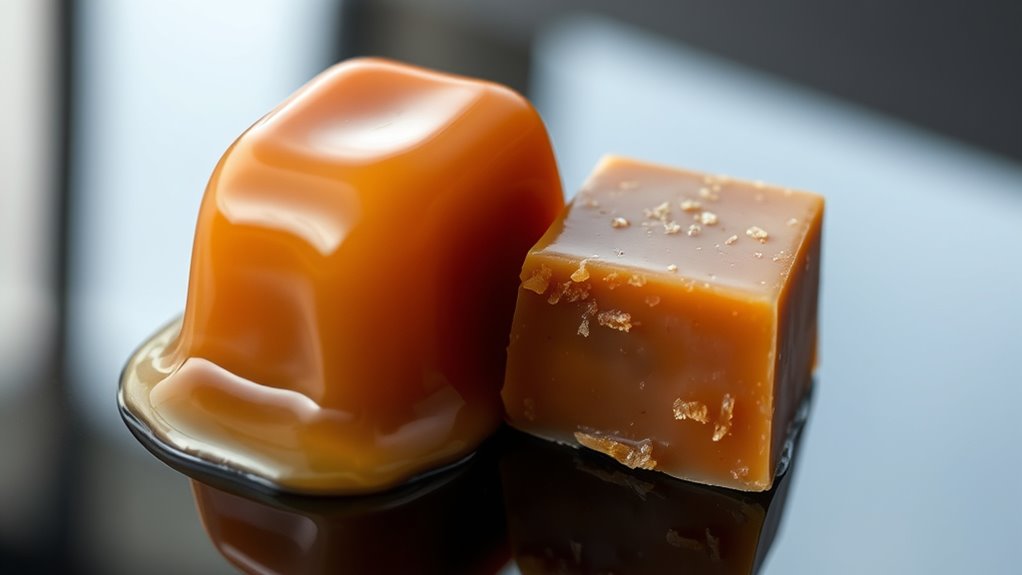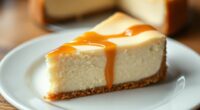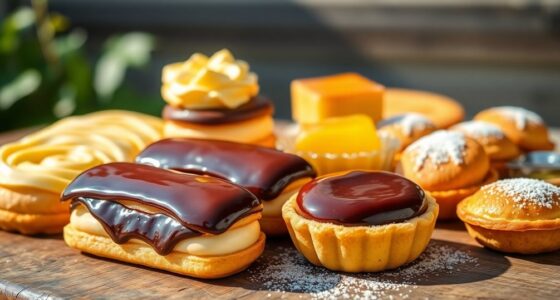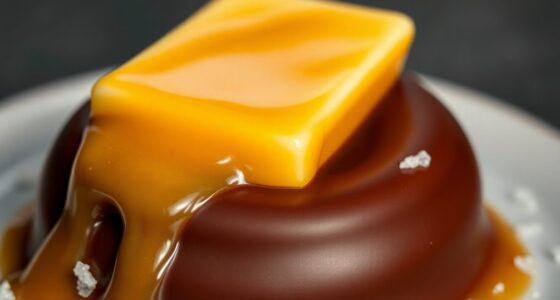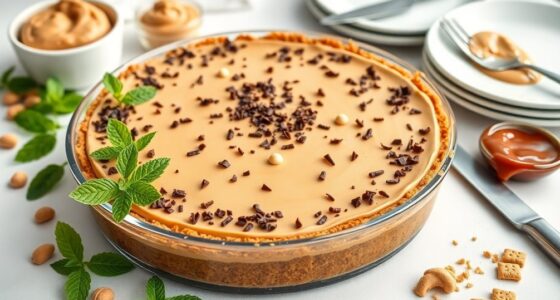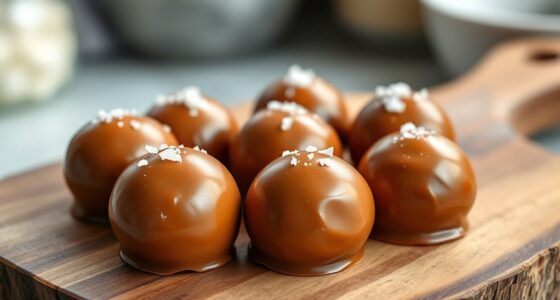To understand the temperature timeline of butter caramel and toffee, you need to monitor sugar temperatures carefully. For butter caramel, aim for around 110°C (230°F) for its soft, chewy texture, while toffee requires reaching higher temperatures—approximately 120°C to 130°C (248°F to 266°F)—to become hard and brittle. Small temperature differences impact flavor and texture, so precise control is key. If you keep focusing on these stages, you’ll master crafting perfect confections every time.
Key Takeaways
- Butter caramel is cooked to a lower temperature (~110-115°C/230-240°F) for a soft, chewy texture.
- Toffee is heated to a higher temperature (~118-120°C/245-250°F) for a hard, brittle consistency.
- Monitoring temperature milestones ensures proper caramelization and prevents burning or graininess.
- Precise temperature control during each stage influences flavor depth and final texture.
- Rushing or misreading temperatures can result in undesirable textures, like soft toffee or overly hard caramel.
Understanding the Basics of Butter Caramel and Toffee

While butter caramel and toffee both start with caramelized sugar, they differ considerably in ingredients and texture. Butter caramel typically combines sugar, butter, and cream, resulting in a smooth, chewy consistency. Toffee, on the other hand, is made with sugar and butter but is cooked longer to reach a higher temperature, creating a hard, brittle texture. Understanding their historical origins helps clarify their differences; butter caramel evolved from traditional European recipes that emphasized cream and butter, while toffee’s roots trace back to 18th-century England, where sugar was boiled to a hard crack. Ingredient substitutions are common—substituting cream in butter caramel can adjust richness, and using different sugars in toffee alters flavor and texture. Recognizing these basics sets the stage for mastering each sweet treat. Additionally, the techniques used in making these confections have evolved over centuries, reflecting innovations in production techniques and cultural preferences.
The Importance of Temperature in Candy Making
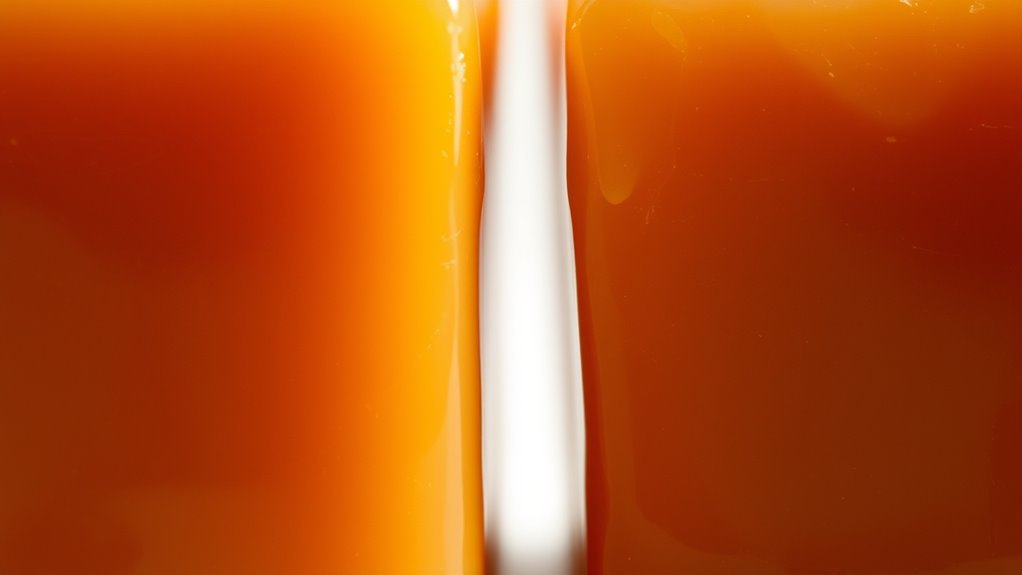
You need to keep a close eye on the temperature while making candy, as even small differences can alter the outcome. Precise control ensures each stage of cooking develops the right flavors and textures. Without it, your butter caramel or toffee might not turn out as perfect as you want. Proper in-home care practices emphasize attention to detail, much like monitoring temperature, to achieve the best results.
Precise Temperature Control
Precise temperature control is essential in candy making because even small variations can dramatically affect the final texture and flavor. When you don’t monitor temperatures closely, sugar crystallization can occur prematurely, leading to grainy candies. Additionally, maintaining the right heat allows moisture evaporation to happen at a steady rate, preventing a sticky or overly soft result. Color accuracy plays a role in showcasing the true appearance of your caramel or toffee, making it look as appealing as it tastes.
To achieve perfect caramel or toffee, keep these points in mind:
- Use a reliable thermometer to monitor temperature accurately.
- Adjust heat carefully to avoid rapid temperature swings.
- Recognize the signs of proper moisture evaporation, like a bubbling, glossy mixture.
Mastering temperature control ensures your candy develops the desired smoothness and consistency, making all the difference in your final product.
Consistent Cooking Stages
Maintaining consistent cooking stages is essential because each phase in candy making depends on specific temperature ranges to develop the desired texture and flavor. If your temperature fluctuates, your candy can become grainy, burnt, or fail to set properly. This consistency is especially important when considering candy storage; improperly cooked candies won’t last as long or maintain quality. When making adjustments, such as ingredient substitutions, precise temperature control becomes even more critical because different ingredients can alter how heat affects the mixture. By sticking to the right temperature stages, you ensure your caramel or toffee reaches the perfect stage for the intended texture, whether chewy or brittle. Accurate temperature control is vital for achieving the ideal consistency and preventing common candy-making mistakes. This disciplined approach guarantees better results, fewer mistakes, and a more delicious outcome every time.
Temperature Stages for Perfect Butter Caramel
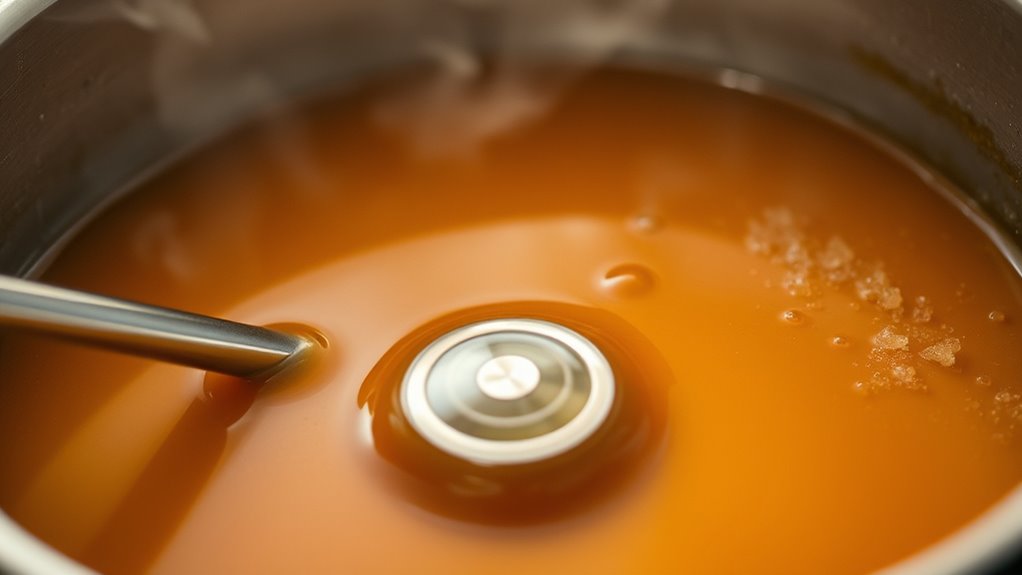
You need to observe your butter caramel carefully as it heats, starting with the initial melting point to guarantee it melts evenly. As the temperature rises, watch for the color development phase, where the caramel gains its rich hue. Finally, understanding when it hardens and sets helps you achieve the perfect texture for your finished treat. Incorporating temperature control techniques can help you manage each stage more precisely for optimal results.
Initial Melting Point
The initial melting point of butter caramel is essential because it marks the beginning of the transformation from solid to liquid, setting the stage for the perfect finish. At this stage, your butter and sugar start to gently heat, initiating the caramelization process. You’ll notice the sugar begins to melt and dissolve, but it’s crucial to watch closely to prevent unwanted sugar crystallization. This initial phase ensures a smooth, even melt, which is vital for achieving the ideal texture later.
- The melting begins around 90°C (194°F), signaling the start of sugar dissolving.
- Proper heat control prevents sugar crystallization that can cause graininess.
- This stage lays the foundation for deep caramel flavors as the process progresses.
Color Development Phase
How does temperature influence the color development in butter caramel? As you heat the mixture, you’ll notice a gradual color change from clear or light golden to a rich, deep caramel shade. This transformation occurs as the sugars caramelize, with higher temperatures accelerating the color change. Reaching the right temperature guarantees your caramel develops a perfect, even caramel shade without becoming too dark or burnt. Monitoring this phase closely is essential because the color indicates the flavor profile; a lighter hue yields milder notes, while a darker shade brings intensified, toasted flavors. Keep a close eye on the thermometer, and remember that the caramel shade will deepen quickly once you hit the desired temperature, signaling it’s time to remove it from heat. Being aware of temperature stages helps in achieving the ideal caramel color.
Hardening and Setting
Reaching the correct temperature is essential for guaranteeing your butter caramel hardens and sets properly. When you hit the right stage, you’ll notice the texture differences become clear—whether it’s a soft, chewy consistency or a firm snap. Proper cooling allows flavors to develop fully, enhancing richness and depth. To get the perfect finish:
- Wait until the caramel reaches the desired temperature before pouring; rushing can lead to uneven setting.
- Allow it to cool completely at room temperature for ideal texture and flavor integration.
- Avoid disturbing the caramel while it’s setting to prevent cracks or soft spots.
- Understanding the different temperature stages, such as soft ball or hard crack, is crucial for achieving the desired caramel texture.
Mastering this stage ensures your butter caramel will have the ideal texture and flavor development, resulting in a beautifully finished treat that holds its shape and delights the palate.
Temperature Milestones for Ideal Toffee
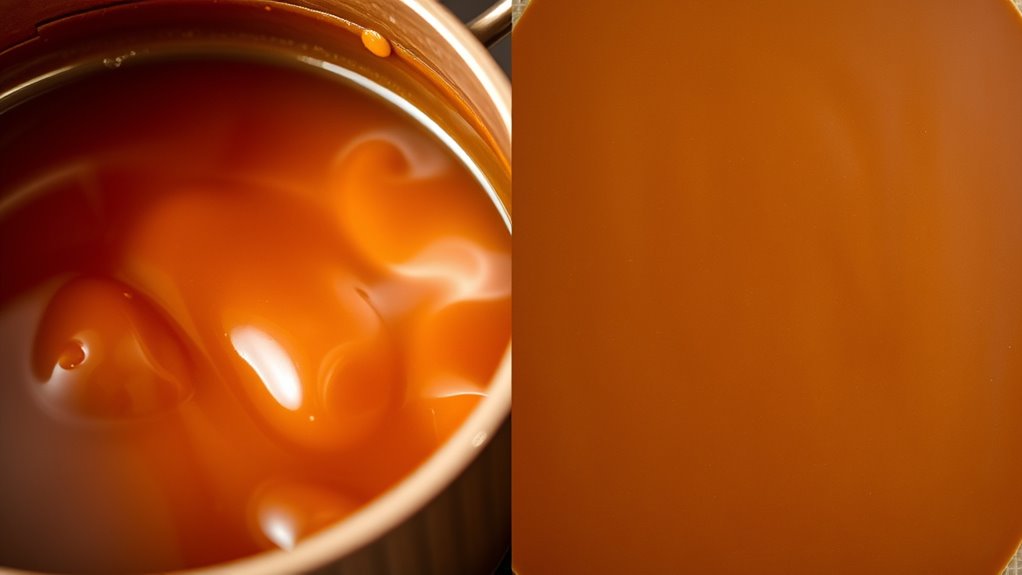
To achieve perfect toffee, paying attention to temperature milestones is essential. As you heat the sugar mixture, you’ll notice key points where sugar crystallization begins and stops, shaping the final texture. Reaching around 230°F (110°C) signals the start of sugar melting, but it’s the moment you hit about 300°F (150°C) that marks the ideal toffee stage. At this temperature, flavor caramelization intensifies, giving the toffee its rich, complex taste. Monitoring these milestones ensures you avoid overcooking, which can lead to bitterness or burning. Using a reliable thermometer helps you stay precise, so your toffee develops the perfect balance of sweetness, crunch, and flavor. Staying within these temperature ranges guarantees a beautifully crafted, delicious treat every time. Regularly checking your candy thermometer during the process can help maintain accuracy and consistency.
How Temperature Affects Texture and Flavor

Once you’ve monitored the temperature milestones during cooking, you’ll notice significant changes in both the texture and flavor of your toffee. As the temperature rises, flavor enhancement occurs, deepening the caramel notes and adding complexity. Simultaneously, texture variation becomes evident: lower temps produce a softer, more chewy consistency, while higher temps create a harder, crunchier treat. Understanding how temperature influences both flavor and texture helps you craft toffee tailored to your preferred consistency and taste profile.
Common Mistakes and How to Avoid Them
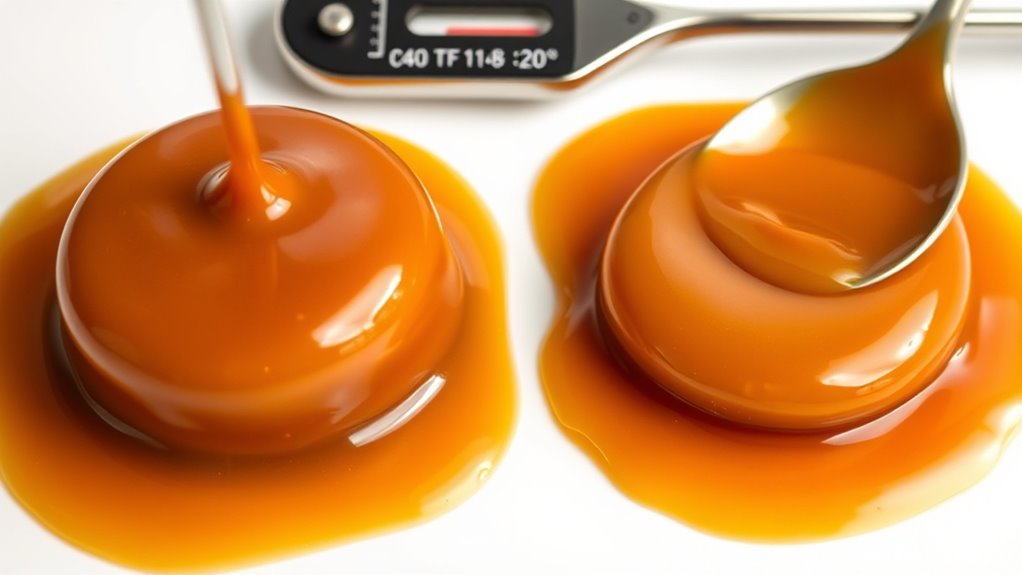
A common mistake when making toffee is overcooking the sugar mixture, which can quickly lead to burnt flavors and an overly hard texture. To prevent this, keep a close eye on the temperature and don’t rush the process. Another common pitfall is making ingredient substitutions without understanding their impact; for example, using margarine instead of butter can alter the texture and flavor. Stick to the recommended ingredients and measurements to ensure consistent results. Also, avoid stirring the caramel once it reaches the desired temperature, as this can cause crystallization. Using a reliable candy thermometer helps prevent errors. Being aware of small mistakes and their consequences can further improve your candy-making skills. By paying attention to these details and sticking to proven ingredient choices, you minimize mistakes and create perfect toffee or caramel every time.
Tips for Achieving Candy Perfection

Achieving candy perfection requires attention to detail and patience throughout the process. To enhance your results, focus on understanding candy flavor profiles and how ingredient substitutions can affect texture and taste. Use a reliable thermometer to hit the precise temperature stages, preventing overcooking or undercooking. Experimenting with different ingredients can add unique twists, but be mindful of how substitutions might alter the final product.
Achieve candy perfection with precise measurements, careful temperature control, and mindful ingredient substitutions.
Here are some tips to help you succeed:
- Keep your ingredients measured precisely to ensure consistent results.
- Watch the temperature carefully, especially during the caramel or toffee stages.
- Don’t be afraid to try small ingredient swaps to customize flavor profiles without compromising texture.
Frequently Asked Questions
Can I Use a Candy Thermometer for Both Butter Caramel and Toffee?
You can use a candy thermometer for both butter caramel and toffee, but verify its accuracy. Different recipes require precise temperatures to achieve the right candy texture, so a reliable thermometer helps prevent overcooking or undercooking. Check your thermometer’s calibration regularly. Using the right thermometer and monitoring temperature closely guarantees perfect textures, whether you’re making smooth butter caramel or crunchy toffee. Accurate readings make all the difference in successful candy making.
How Does Humidity Affect the Candy-Making Temperature Process?
You might think humidity effects won’t impact your candy, but weather influence really matters. High humidity can cause sugar to seize or not reach the right temperature, making your candy sticky or too soft. To get perfect results, work in a dry environment, especially in humid weather. Keep an eye on the weather influence and adjust your cooking time or technique accordingly. This ensures your butter caramel or toffee turns out just right.
What Are Alternative Methods to Temperature Control in Candy Making?
You can use sight and texture as alternative temperature controls in candy making. By observing the color change and the firmness of the mixture, you gain valuable cues. Timing and experience are essential, as seasoned candy makers recognize visual and tactile signs indicating readiness. While precise thermometers are helpful, trusting your senses allows you to adjust the process dynamically, ensuring perfect consistency without solely relying on temperature readings.
How Do Different Types of Sugar Impact the Temperature Timeline?
You should consider how different sugar types impact your temperature timeline because each has unique caramelization points. For instance, sucrose caramelizes around 320°F, while glucose melts sooner, affecting your cooking process. Using various sugar types influences how quickly your mixture reaches the desired stage, so you need to modify your heat accordingly. Monitoring these caramelization points helps ensure your candy achieves the perfect texture and flavor.
Is There a Visual Cue to Tell When the Candy Has Reached the Right Stage?
You watch your candy carefully, waiting for that perfect moment. A visual cue emerges—color starts to deepen, and bubbles grow larger and slower. When you see a rich amber hue and the bubbles become thick and slow, you know you’re reaching the right stage. Keep your eye on these signs, because they’re your best clues to perfect caramel or toffee, even without a thermometer.
Conclusion
Mastering butter caramel and toffee is like fine-tuning a symphony—you need the perfect temperature to bring out their true character. By understanding their temperature milestones, you’ll turn simple ingredients into golden, luscious treats that dance on your palate. So, stay attentive, avoid common pitfalls, and enjoy the sweet reward of candy-making mastery. With patience and precision, you’ll create confections that are nothing short of edible art—delicious, beautiful, and unforgettable.
